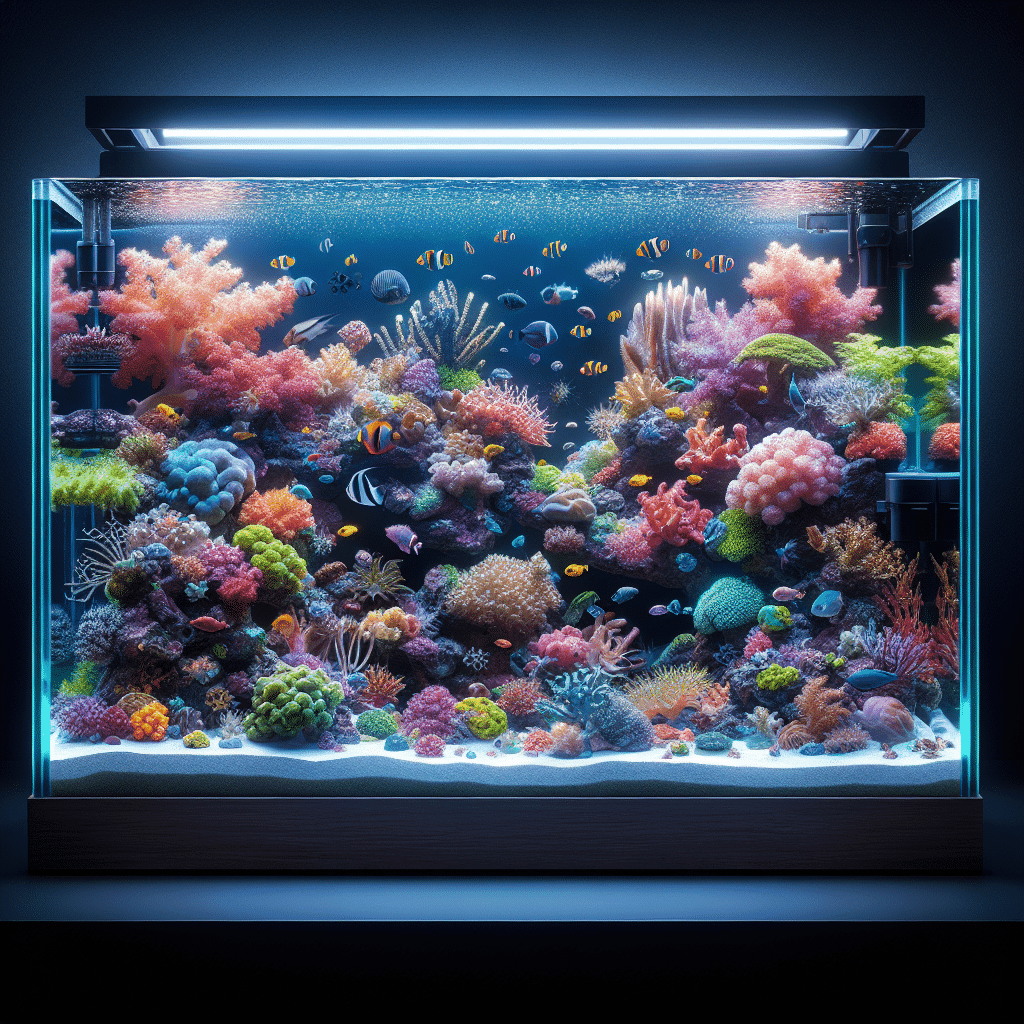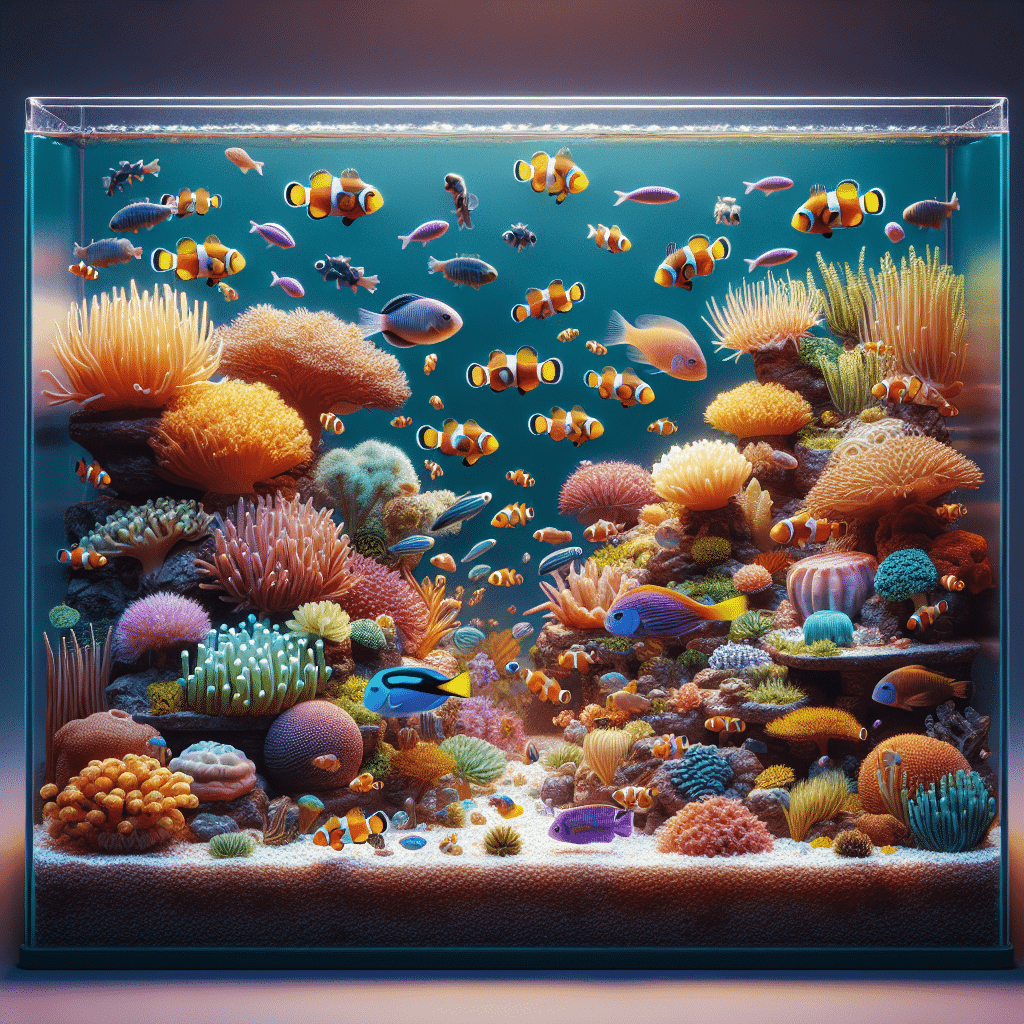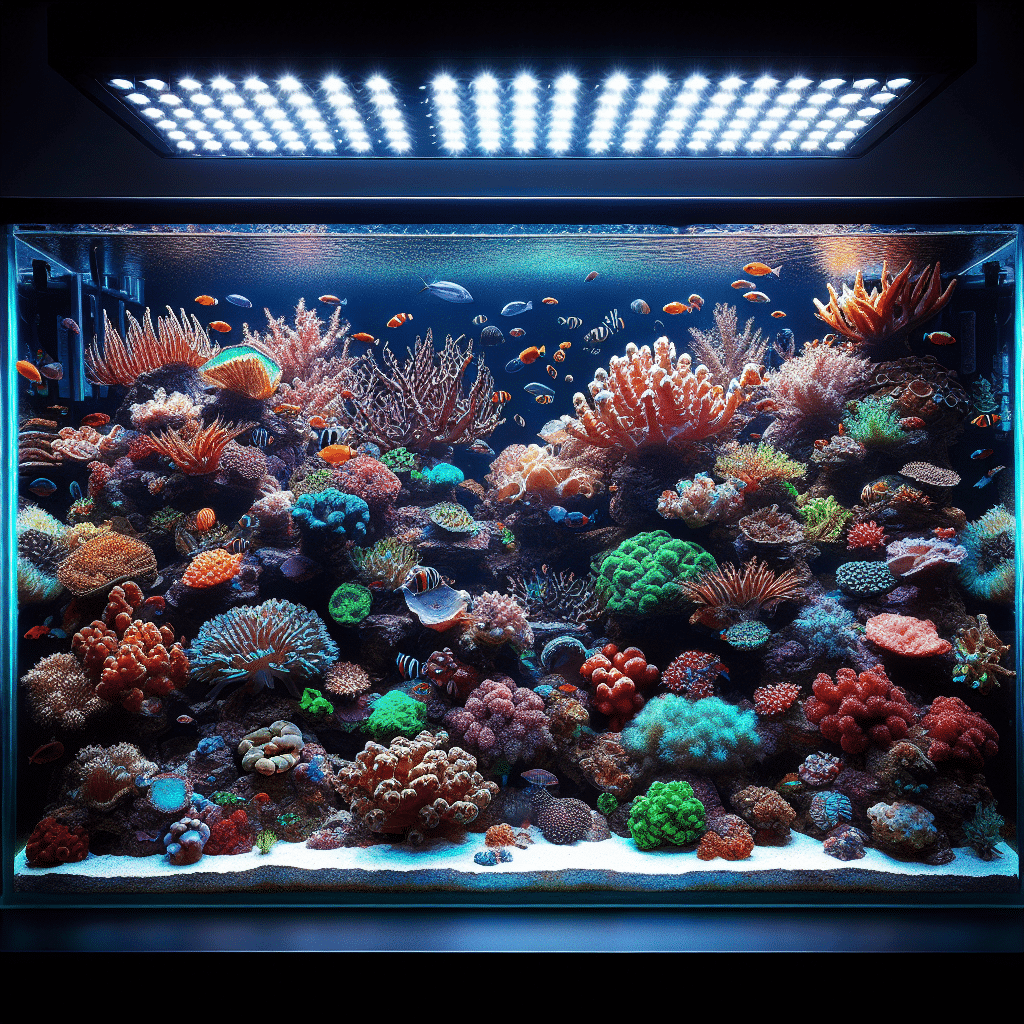Best Nano Reef Tanks
Creating a thriving nano reef tank involves understanding its essential components and making informed decisions about tank size. This guide will provide insight into what you need to get started.
Essential Components for Best Nano Reef Tanks
Setting up a nano reef tank requires specific supplies to ensure a healthy environment for fish and corals. Here are the basic components needed for a successful setup:
| Component | Description |
|---|---|
| Aquarium | The main tank where the aquatic life will reside. |
| Powerhead or Wave Maker | Creates water movement to simulate ocean currents. |
| Refractometer | Measures the salinity of the water, essential for marine environments. |
| Quality Reef Lighting | Provides appropriate lighting for coral growth. Options include Kessil A80 and AI Prime HD. |
| Sand or Bare Bottom | Depending on your preference; sand provides a natural look and habitat. |
| RO/DI Water or Distilled Water | Ensures purity and appropriate conditions for marine life. |
| Reef Aquarium Salt Mix | Essential for creating the right salinity in the tank. |
| Live Rock | Provides biological filtration and habitat for marine life. |
| Filter | Maintains water quality by removing debris and toxins. |
| Heater | Keeps the water at a stable temperature. |
Additional items that can enhance your nano reef tank include an aquarium lid, filter media, an automatic top-off system, a sump for external filtration, and a protein skimmer. For detailed setup guidance, check out our article on nano reef tank setup.
Tank Size Considerations
The size of a nano reef tank is crucial for maintaining a balanced ecosystem. A typical nano reef tank is often considered to be 30 gallons or less. For instance, a 30-gallon tank measuring 36 x 12 x 16 inches is generally at the upper limit for a nano-reef system, providing enough volume to house various fish and invertebrates without significantly increasing risk (TFH Magazine).
When choosing the size, consider the following:
| Size Category | Gallon Range | Benefits |
|---|---|---|
| Small | 5 – 10 gallons | Easier to manage and maintain, lower cost. |
| Medium | 10 – 20 gallons | More stocking options, better stability. |
| Large | 20 – 30 gallons | Increased biodiversity, more room for corals and fish. |
A larger tank generally provides better stability in water parameters, which is essential for the health of the aquatic life. However, larger tanks may require more equipment and maintenance. It’s important for hobbyists to research and prepare thoroughly before starting their nano reef journey. For ongoing care, explore our section on nano reef tank maintenance.
Setting Up Your Nano Reef Tank
Creating a thriving nano reef tank involves several key steps. From cycling the tank to selecting the right livestock and establishing a maintenance routine, each component plays a crucial role in the success of the aquatic environment.
Tank Cycling Process
The first step in setting up a nano reef tank is the tank cycling process. This crucial phase allows the tank to establish beneficial bacteria that convert toxic ammonia into nitrites and then into less harmful nitrates. It is advised to let the tank cycle for several weeks before adding any inhabitants such as snails, crabs, or fish. Once the tank shows zero ammonia, zero nitrites, and nitrates below ten, it is considered safe for adding livestock (Nano-Reef).
| Parameter | Ideal Value |
|---|---|
| Ammonia | 0 ppm |
| Nitrites | 0 ppm |
| Nitrates | Below 10 ppm |
Selecting Livestock
Choosing the right livestock is essential for creating a balanced ecosystem in a nano reef tank. It is important to consider compatibility and the specific needs of each species. Beginners may want to start with hardy species, such as certain types of nano reef tank fish and invertebrates that can adapt to changing conditions.
Some popular choices for nano reef tanks include:
| Livestock Type | Examples |
|---|---|
| Fish | Clownfish, Gobies |
| Invertebrates | Snails, Hermit Crabs, Shrimp |
| Corals | Zoanthids, Mushrooms, Soft Corals |
Choosing a mix of livestock can enhance the biodiversity of the tank and create a more vibrant underwater oasis. For more information on choosing corals, visit our section on nano reef tank corals.
Proper Tank Maintenance
Maintaining water quality and overall tank health is vital for the longevity of a nano reef tank. Regular maintenance routines should include water changes, detritus removal, and equipment upkeep.
Water Changes: Regular water changes of 10-20% per week are recommended to address waste in the water column and replenish trace elements in nano reef tanks.
Detritus Removal: Removing detritus from live rock and live sand is crucial for maintaining a healthy environment. Techniques include using a turkey baster or power head for live rock and a siphon hose or gravel vac for live sand.
Equipment Maintenance: Proper maintenance of pumps, heaters, and lighting is necessary to ensure consistent water flow, temperature, and cleanliness.
By following these guidelines for tank cycling, selecting livestock, and performing regular maintenance, individuals can successfully set up a thriving nano reef tank. For more detailed information on tank setup, refer to our article on nano reef tank setup.
Maintaining Water Quality
Maintaining water quality is essential for the health of a nano reef tank. Regular monitoring and maintenance practices help create a stable environment for fish and corals. This section covers crucial aspects of maintaining water quality, including water changes, detritus removal, and testing parameters.
Water Changes
Regular water changes are vital for the upkeep of a nano reef tank. It is generally recommended to perform water changes of 10-20% per week to address waste in the water column and replenish trace elements. This practice helps maintain water clarity and supports the overall health of the tank’s ecosystem.
| Frequency | Water Change (%) | Purpose |
|---|---|---|
| Weekly | 10-20% | Remove waste and replenish trace elements |
Using reverse osmosis/deionized (RO/DI) water for mixing synthetic seawater is recommended to prevent impurities from affecting water quality. It is also advisable to keep at least 10 gallons of mixed seawater stored and circulating at all times for tanks of around 30 gallons, changing at least 5 gallons weekly to maintain stability (TFH Magazine).
Detritus Removal
Detritus, or decomposing organic matter, can accumulate in a nano reef tank and negatively impact water quality. Regular removal of detritus from live rock and live sand is crucial for maintaining a healthy environment. Techniques for effective detritus removal include:
- Using a turkey baster or power head to blow detritus off live rock
- Employing a siphon hose or gravel vac for cleaning live sand (Nano-Reef)
Incorporating routine detritus removal into the maintenance schedule helps prevent nitrate and phosphate buildup, which can inhibit algae growth.
Testing Parameters
Regularly testing water parameters is essential for maintaining a balanced system in a nano reef tank. Key parameters to monitor include salinity, nitrate, phosphate, and temperature. It is crucial to match food input with water changes and detritus removal to keep nitrate and phosphate levels low (Nano-Reef).
| Parameter | Recommended Range |
|---|---|
| Salinity | 1.023 – 1.025 specific gravity |
| Nitrate | < 5 ppm |
| Phosphate | < 0.03 ppm |
| Temperature | 75�F – 82�F |
Using phosphate-reducing filter media and maintaining proper oxygen exchange with powerhead or wave maker placement can further improve water quality (Nano-Reef). Keeping a close eye on these parameters ensures a stable and healthy environment for both fish and corals in the best nano reef tank. For further guidance on tank setup, refer to our article on nano reef tank setup.
Reef Tank Equipment
When setting up a nano reef tank, having the right equipment is essential for creating a thriving aquatic environment. This section will cover crucial components such as lighting options, water flow pumps, and protein skimmers.
Lighting Options
Proper lighting is vital for the health of corals and other photosynthetic organisms in a nano reef tank. The best nano reef tank lighting should provide the right intensity and spectrum for coral growth.
One of the top choices for nano reef lighting is the AI Prime HD. It offers absolute control over color, intensity, and built-in timer functions, making it suitable for mini reef tanks up to 20 inches cubed. With 55 watts of power, it can be controlled via smartphone, allowing for easy adjustments and monitoring (Reef Builders).
| Lighting Option | Power (Watts) | Suitable Tank Size (inches) | Control Type |
|---|---|---|---|
| AI Prime HD | 55 | Up to 20 | Smartphone |
For more lighting options, check out our guide on nano reef tank lighting.
Water Flow Pumps
Water flow pumps are essential for creating movement in the tank, which benefits corals and helps maintain water quality. Two excellent options for small tanks are the Tunze NanoStream 6040 and 6020. The 6020 is priced just over $40 and provides gentle water flow without creating excessive turbulence. The controllable 6040 is priced higher but offers more features and customization (Reef Builders).
Another notable option is the Aqamai KPS, a wireless and programmable nano reef pump priced at $99. It allows users to change flow speed and wave patterns through an app, providing advanced control for various tank setups (Reef Builders).
| Pump Model | Price | Features |
|---|---|---|
| Tunze NanoStream 6020 | $40+ | Gentle flow |
| Tunze NanoStream 6040 | Higher | Controllable |
| Aqamai KPS | $99 | Wireless, programmable |
For further insights on filtration systems, visit our page on nano reef tank filtration.
Protein Skimmers
A protein skimmer is an important piece of equipment for maintaining water quality in a nano reef tank. It removes organic compounds and waste before they break down and affect the water quality. While specific models were not detailed in the context provided, it is essential to choose a skimmer that fits the size of the nano reef tank and is efficient for the bioload.
For guidance on selecting the best skimmer for your setup, check our article on nano reef tank equipment.
Choosing the right equipment contributes significantly to the success of a nano reef tank. With the right lighting, water flow, and filtration systems, one can create a beautiful and healthy aquatic environment for fish and corals.
Coral Placement Strategies
Successfully managing a nano reef tank requires careful planning when it comes to coral placement. This section explores three key strategies: flow considerations, coral compatibility, and managing aggression among corals.
Flow Considerations
Flow rate is a critical factor in the health of corals. Each coral species has specific flow preferences; some thrive in high flow while others prefer low flow environments. When setting up a nano reef tank, it’s essential to assess the flow requirements of the corals being kept.
| Coral Type | Flow Preference |
|---|---|
| SPS Corals | High Flow |
| LPS Corals | Moderate Flow |
| Soft Corals | Low to Moderate Flow |
Starting with small frags rather than larger colonies can help corals acclimate to each other’s presence, promoting tolerance and reducing stress. Slight adjustments in placement can significantly impact coral health and growth, making it vital to monitor water movement in the tank.
Coral Compatibility
Coral compatibility is essential for maintaining a thriving mixed reef environment. Some corals can be more aggressive than others, using sweeper tentacles or engaging in chemical warfare. For instance, leather corals can be particularly challenging in mixed setups due to their specific requirements and potential for aggression.
| Coral Type | Compatibility Notes |
|---|---|
| SPS Corals | Prefer higher light and flow; sensitive to nutrient fluctuations. |
| LPS Corals | May require specific nutrient levels; can coexist with soft corals. |
| Soft Corals | Generally more adaptable but can be outcompeted by aggressive species. |
It’s crucial to ensure that nutrient levels like nitrate and phosphate are maintained, as very low levels can hinder the health of soft and LPS corals (Nano-Reef).
Managing Aggression
In a mixed reef tank, some corals may dominate over time, leading to overcrowding and aggression. To manage this, regular monitoring and potential fragging or removal of corals may be necessary. Controlling parameters like nutrient levels can help delay conflicts, but aggressive species may need to be removed entirely if they start to threaten the health of other corals.
| Coral Species | Aggression Level |
|---|---|
| Acropora (SPS) | Moderate to High |
| Euphyllia (LPS) | Low to Moderate |
| Xenia (Soft Coral) | Low |
Maintaining a harmonious environment requires vigilance and ongoing adjustments. By understanding the dynamics of coral placement, compatibility, and aggression, enthusiasts can create a thriving environment in their nano reef tank. For more insights on other aspects of maintaining a nano reef, feel free to explore our articles on nano reef tank corals and nano reef tank maintenance.
Challenges in Mixed Reef Tanks
Creating a thriving mixed reef tank can present several challenges, particularly when managing coral species. Understanding these challenges is essential for anyone considering the best nano reef tank setup.
Coral Dominance
In a mixed reef environment, it is common for more powerful coral species to dominate the space over time. This dominance can lead to issues such as overcrowding and competition for resources. Fragging or removing corals may be necessary to control their growth and prevent negative impacts on tank health.
| Coral Type | Growth Rate | Potential for Dominance |
|---|---|---|
| Leather Corals | Medium | High |
| Soft Corals | Medium | Medium |
| LPS Corals | Slow to Medium | Low to Medium |
| SPS Corals | Fast | High |
Certain corals, like leather corals, can complicate maintenance due to their specific requirements and aggressive growth habits. It’s crucial to regularly monitor coral health and growth to ensure a balanced environment.
Coral Warfare
Coral warfare occurs when certain species release toxins or deploy sweeper tentacles to compete for space and resources. This behavior can lead to significant stress and damage among tank inhabitants. Some coral types, particularly SPS corals, prefer specific lighting and water flow conditions, which can exacerbate conflicts if their needs are not met.
To minimize coral warfare, it is essential to ensure that nutrient levels, such as nitrate and phosphate, remain balanced. Extreme fluctuations can lead to stress and aggressive behavior among corals. If aggressive species become problematic, removal may be necessary to maintain harmony within the tank.
Managing Coral Growth
Managing coral growth is vital for maintaining a healthy mixed reef tank. Overgrowth can lead to overcrowding and competition for light and nutrients. Regular maintenance practices, such as trimming and fragging corals, can help control growth and keep the tank balanced.
| Management Strategy | Description |
|---|---|
| Fragging | Cutting corals to promote healthier growth and prevent dominance. |
| Removing Aggressive Species | Taking out overly aggressive corals to maintain tank harmony. |
| Monitoring Nutrient Levels | Ensuring nutrient levels are at appropriate levels to support all coral types. |
It’s important to pay attention to the specific needs of different coral species. Maintaining stable water parameters, including temperature and salinity, can help minimize growth-related challenges. For a more comprehensive approach to setting up and maintaining your tank, explore our articles on nano reef tank setup and nano reef tank maintenance.



